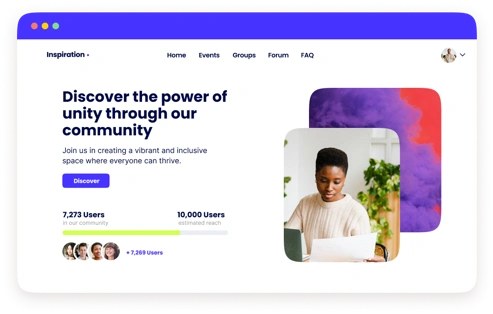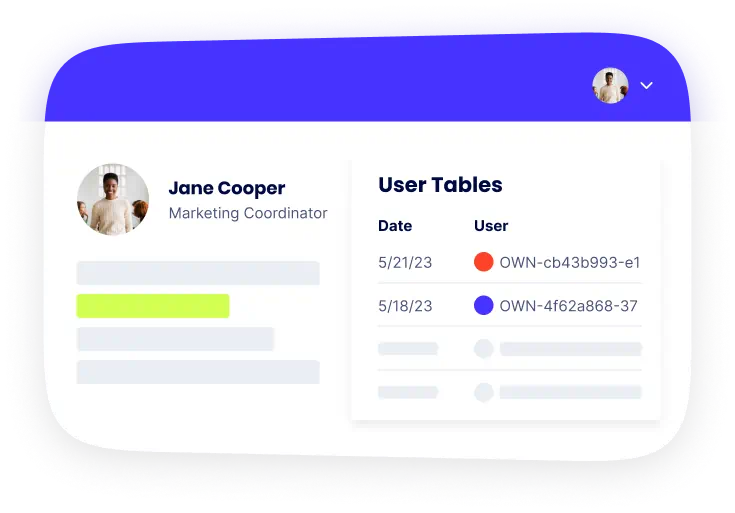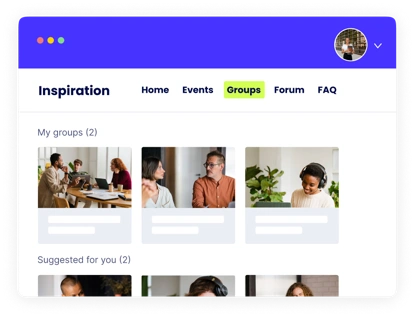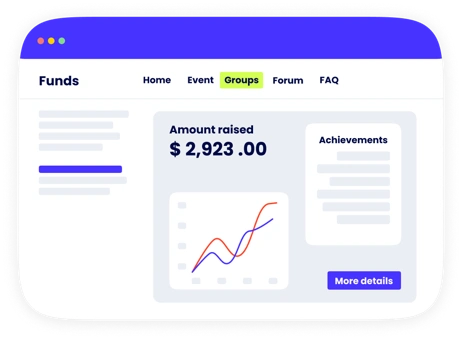Reinforce and project your brand and cultural identity
Align every part of your community platform to your visual brand, and promote the importance of a member-led strategy to extend reach and deliver impact.
Learn more
Online community management involves building, nurturing, and facilitating engagement within a digital setting. Sometimes online communities are unaffiliated with an organization, but more often than not, they are established and nurtured by an organization to support a specific goal such as generating leads, increasing sales, or building loyalty.
A critical component of community management is ensuring consistent strategic alignment between the activities and goal(s) of the online community and the goal(s) of the organization. This involves regularly communicating with stakeholders to understand organizational priorities and finding ways for the community to contribute to those priorities—this could be through gathering customer insights, enhancing member experience, or driving volunteer recruitment.
By demonstrating the community’s value to the organization, the community manager can secure resources, support, and buy-in from leadership to enhance the community’s impact and sustainability.
The role also typically includes responsibilities such as:
Align every part of your community platform to your visual brand, and promote the importance of a member-led strategy to extend reach and deliver impact.
Learn more
Manage your community effectively with customization, platform administration, and data reporting.
Learn more
Connect with your audience and drive action with Hivebrite provides content and communications platforms.
Learn more
Facilitate community connections through custom groupings, searchable profiles, and frictionless messaging.
Learn more
Monetize your community and increase revenue through ticketed events, merchandise sales, donations, and more.
Learn more
Online community management encompasses various approaches and strategies tailored to different communities’ specific needs and goals. At Hivebrite, we categorize communities into the following categories:
Commercial communities’ fundamental objective is to generate income for their owners, shareholders, and investors. This can be done in a variety of ways:
Non-profit communities’ key objective is to focus on social causes and make a positive impact. This can be done in several ways:
The key objective of collective and association communities is to cater to members’ needs and interests. A community can do this through:
Education communities’ key objective is to identify and serve the needs of alumni, students, and external stakeholders. This can be done through:
You can be authentic as a community manager by openly sharing your experiences while genuinely engaging with members to build trust and rapport within the community.
Have the courage to be vulnerable and share your own challenges and failures within the community. Being vulnerable fosters trust, empathy, and deeper connections as it allows for authentic and meaningful exchanges that promote mutual understanding and support.
Strive to establish personal connections with members to understand their individual needs, concerns, and aspirations. This involves actively engaging in conversations and offering personalized support when needed.
Embody the behaviors and values you wish to see reflected in the community. Follow your community guidelines to the letter, actively participate in discussions, promptly reply to queries, and consistently demonstrate respect towards your members.
Recognizing and appreciating the contributions of community members fosters a sense of belonging and encourages continued engagement. This can be done through public acknowledgments, rewards, or personalized messages of gratitude.
Champions are enthusiastic and engaged members who actively promote and support the community’s goals. Identify and nurture your champions and leverage their influence to drive positive engagement and growth within your community. You could invite champions to participate in special projects or initiatives, empowering them to take on leadership roles within the community.
Clearly demonstrate your community’s impact on your organization to secure ongoing support and resources for community initiatives.
Showcase tangible outcomes based on your community’s and organization’s goals—decide the best metrics for tracking your community’s success with our spreadsheet!
Create opportunities for members to contribute ideas, share expertise, and collaborate. Organize regular discussion topics, challenges, or events to stimulate interaction and participation among members.
Consider creating specialized groups within the community based on criteria such as interest or maturity to offer spaces for more targeted exchanges.
Remember that for your community to achieve its goals, your members need to feel safe and supported.
Community guidelines explain how members should interact with each other, what is allowed, what isn’t, and the consequences for breaching the rules. Guidelines help safeguard your members while encouraging the culture you want to create within your community.
What your guidelines cover will depend on your type of community. For example, consider a dedicated terms and conditions page if your community shares sensitive documents. However, any community should create rules around the following:
Get our guide on creating community guidelines with examples and a free template here.
In communities where diversity, equity, and inclusion (DEI) are prioritized, members from diverse backgrounds feel valued, respected, and represented. Everyone can belong, authentically contribute, and flourish.
Some starting points for evaluating your community’s DEI include:
Download our guide for tips and expert advice on how to build an inclusive community.
Community management is an iterative process, and it’s essential to evaluate and evolve strategies based on feedback and data continuously. Be open to experimentation, testing new approaches, and learning from both successes and failures to drive continuous improvement.
Try conducting surveys or focus groups to gather feedback from members about their experiences and preferences, using this information to refine community initiatives and engagement strategies over time.
This checklist will help you assess your community management practices from the ground up. Use it to pinpoint your strengths and areas that need a bit of fine-tuning in managing your online community.